Cobwebs of cosmic dust limit how far we can see into the Milky Way's hub, but Baade's Window offers a rare glimpse into the stellar riches that await us there.
Somewhere I read that if you could vacuum up all the dust that obscures the core of the galaxy, the summer Milky Way in Sagittarius would be bright enough to cast shadows. That's how lousy with cosmic dust our home is.
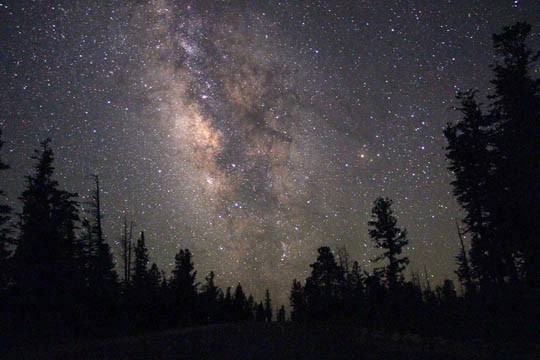
Stephen Bockhold
I have nothing against the tiny dust motes that glitter blackly between the stars. After all, we're made of the same, born on a planet brewed and steeped in a long-forgotten dark cloud. But wouldn't it be nice to see deeply across the galaxy without getting dust in your eyes? To peer all the way to the Milky Way's center 25,000 light-years away? Well, you can, thanks to a fortuitous sucker hole called Baade's Window.
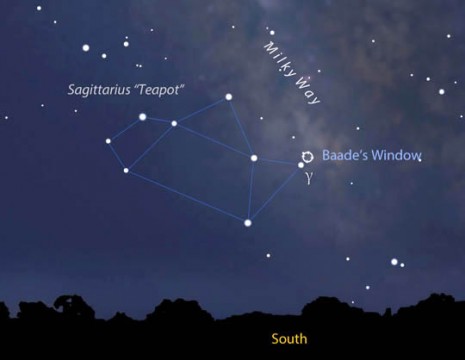
Stellarium
Named for Mt. Wilson astronomer Walter Baade who first recognized its significance, this porthole into deep space spans about 1° in diameter centered on the globular cluster NGC 6522 in Sagittarius. Though small, Baade's Window serves up one of the brightest visible patches of the Milky Way.
Baade employed it and five other smaller clearings to examine RR Lyrae variables in the galactic core region. Similar to Cepheid variable stars, members of the RR Lyrae clan have periods related to their intrinsic luminosity, making them excellent distance indicators. Using them, Baade estimated that the galactic central point hovers 27,000 light-years from the Sun, a distance since refined to about 26,000 light-years.
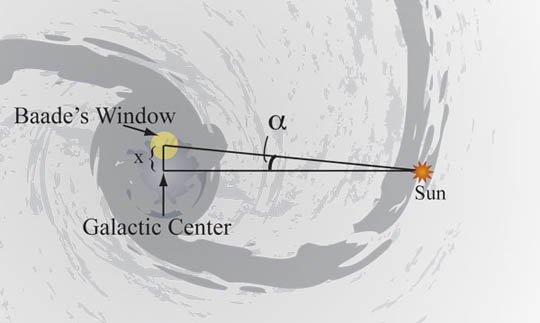
University of Michigan / Sally Oey and Shannon Murphy
What a wonderful opportunity to peer across so much interstellar space virtually unimpeded by dust. What lurks there? Photos show a star field so dense it looks like an explosion at a glitter factory. Sitting squarely in the center of this stellar scintillation is the bright, compact globular cluster NGC 6522, shining some 20,000 light-years from your front door. At magnitude +8, even a small telescope will show a 3′-wide fuzzy patch with a bright, compact center.
You're not likely to resolve this globular's core, but observers with 12-inch or larger telescopes can tease out some of the many 14th-magnitude and fainter stars flecking its halo. The cluster has a clumpy look through my 15-inch reflector at 257x with a smattering of faint stars poking from the halo with averted vision.
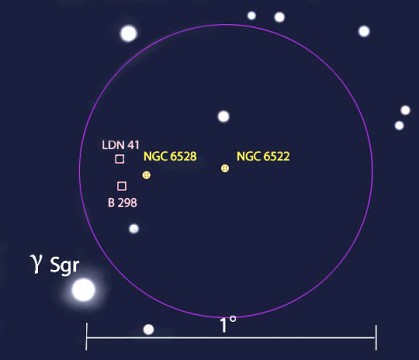
Stellarium
While NGC 6522 isn't likely to grab your attention like the Hercules Globular (M13), it has at least one superlative to its name. At 12 billion years old, it may be the oldest star cluster in the galaxy. NGC 6522 lies within the Milky Way's 10,000-light-year-wide galactic bulge, the dense core of our galaxy packed with hundreds of millions of aged, yellow stars.
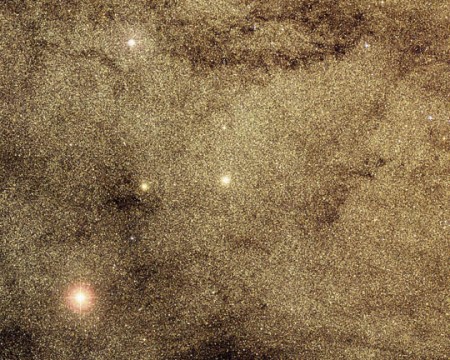
Copyright: Australian Astronomical Observatory/David Malin
The moment you find NGC 6522, you'll probably spot its neighbor, NGC 6528, just 20′ to the east. It seems fainter than its listed magnitude of +9.6, with a compact but dimmer core dressed up in a similar-sized but fainter, more diffuse halo. The two form a nifty pair like Leo's M65-66 galaxy duo or the Double Cluster in Perseus. At ~25,800 light-years distant, NGC 6528 resides closer to the center of the Milky Way's bulge than its mate and has been around nearly as long, with an age of 11 billion years.
Using low magnification and averted vision, both clusters look like melted marshmallows against a powdered sugar backdrop of very faint stars. The stars are so thick around NGC 6522 they create the illusion of expanding the globular's halo to titanic dimensions!
My view through the portal is compromised somewhat by my latitude. From northern Minnesota, Baade's Window never climbs higher than 13°... just high enough for a satisfying look. From the central U.S., its elevation improves to 20°. It only gets better the farther south you call home.
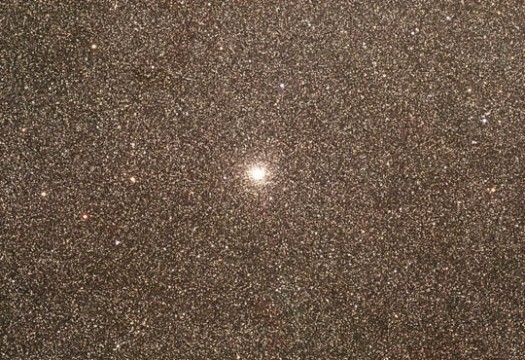
Copyright: Australian Astronomical Observatory/David Malin
Dark nebulae shadow the Window's edges just east and north of NGC 6528. Moderate-sized telescopes will reveal two star-poor patches — Barnard 298 and Lynds 41. B298 lies 12′ southeast of 6528 and extends 10′ east-west. Use averted vision and low-to-medium magnification to see it best. Lynds 41, smaller and somewhat less distinct, appears connected to B298. As you wend your way south toward the orange giant Gamma Sgr, other dark nebulae creep into view, reminding you just how narrow this aperture truly is.
Every morning I pull up the shades and look out the window to see what the new day will bring. May Baade's Window bring fresh sights to your nights.
Want to learn more about astronomy? Sign up for a subscription to Sky & Telescope and we'll give you the universe!
 3
3









Comments
Ernie Ostuno
June 10, 2015 at 5:45 pm
I have been to two places where the star clouds of Sagittarius actually DO cast shadows on the ground; Fort Davis, Texas and La Serena, Chile.
In Chile, the center of the galaxy passes overhead and you get the distinct impression of looking at an edge-on spiral galaxy...from the inside.
You must be logged in to post a comment.
Bob KingPost Author
June 13, 2015 at 10:50 pm
Ernie,
Wow! I can hardly imagine the sight of the Milky Way casting shadows. Happy to know some can see it. Thanks for your comment.
You must be logged in to post a comment.
Anthony Barreiro
June 15, 2015 at 4:25 pm
Bob, thanks for this. I didn't know about Baade's window before reading your article. This past Saturday night at the monthly members star party of the San Francisco Amateur Astronomers, we took a look at NGC 6522 and 6528 through a 12-inch Dobsonian reflector. We were on top of Mount Tamalpais with a relatively dark sky for the SF bay area, but Sagittarius was low to the south, in the worst of the light pollution. We were able to see the globular clusters clearly, and the background sky was rather granular with background stars, but I didn't get the impression of looking through a window. I'll hope to try again from a darker location. Heck, maybe someday I'll go to Chile.
By the way, Walter Baade had a fascinating life story. He doubled the size and age of the universe!
You must be logged in to post a comment.
You must be logged in to post a comment.